I love pouncing coyotes! And I don’t think I’m alone – these airborne coyote shots are by far some of the most popular images on the site. They also generate a few questions from time to time, so I thought they were a good candidate for the “How I Got The Shot” series.
These photos were captured back in 2013 in Yellowstone National Park – just after a late lunch.
Earlier that day I had not one, not two, but three awesome grizzly bear encounters at three separate times! So, by early afternoon, I was pretty well satisfied with my photographic catch and not feeling pressured to find anything else. I planned to start working my way back to my hotel (maybe I’d be there before dark for a change), and if anything particularly good popped up along the way, I’d consider it a nice bonus. Still, I felt like I had already exceeded my quota of great photos for that day.
However, the photography gods were still smiling on me that afternoon. 🙂
Before we get too far, allow me to share a little background with you. You have to understand that I really love coyotes. I know, not everyone is a fan, but I can’t help it – they’re one of my favorite animals.
I think a large part of my favoritism stems from my admiration of the aerial pounce they sometimes employ when pursuing prey. Their approach is decidedly cat-like in its execution and incredibly graceful to watch.
So, there I was, driving along, eyes alert for anything exciting when I spot this coyote out in a field. I quickly extracted my gear from the back of the truck, with hopes of getting a few nice “posed” shots of him majestically surveying the meadow – little did I know what was in store.
As I approached, he stopped and stared intently at a small area of vegetation – no doubt a mouse had tried to scurry away but waited too long to make his move. The coyote crouched down, cat-like, gave a slight wag with his entire body (a sure sign of an imminent pounce), and sprang into the air. The pounce was flawless – he fell upon on his prey and came up chewing.
YES! He was a pouncer!!
Now I was excited. Not all coyotes are pouncers, many just sneak up and snag from behind in a hurried, brute fashion that no one would call elegant. However, this particular ‘yote had some serious flare and seemed to favor a dramatic leap to catch his dinner. The first pounce was a bit too far out for a good photo, but I knew if he’d allow a closer approach I might have a shot.
So, with my D4 (remember, this was 2013) and 600mm F4 (with 1.4TC) mounted to my Gitzo 5 series tripod, I headed out to the meadow.
Back then, my D4 was my go-to camera, and frankly, if this opportunity came up now I would probably grab my D5 over my D850 (or anything else in my bag) simply for those insane 12 FPS.
When you’re trying to capture a coyote in mid-air, a high frame rate is your best friend. It’s not that you can’t get shots like these with a slower camera, it’s just that you get more OPL (opportunities per leap – you heard it here first 🙂 ) with a high frame rate. Figure a jump lasts about 1/2 second, so my D4 gave me 5 OPL, the D850 would be 4.5, and the D5 would snag 6 OPL.
Shutter speed is also critical in this scenario, and you likely need more than you think, especially for the “launch” portion of the leap. In reviewing my original images for this article, I discovered I was around 1/1200th for the first pounce. I must have noticed the images were a touch soft upon verifying them on the back of the camera because for the next set I bumped the ISO to 1000 and ended up at 1/3200th of a second. (This was when I was just starting my transition to Manual + Auto ISO, so I was still leaning on Aperture Priority for shots I deemed important – well that and regular manual mode).
I mentioned that I checked the image on the back of the camera for a very particular reason. From time to time, you’ll see some internet “pro” announce that “real” photographers never chimp (i.e., check their images on the back of the camera). Well, I ALWAYS do – and for this very reason.
Had I arrogantly assumed everything was fine, we wouldn’t be having this conversation right now. One key advantage with digital photography is that it allows you to verify your images and make adjustments on the spot if there’s a problem. I think ignoring that option tosses away one of the most significant benefits of digital photography – and that’s nuttier than a squirrel turd.
The secret is to do quick checks between the action – you NEVER want to miss shots because you were gawking at the back of your camera. However, I think it still pays to take a peek now and then as opportunities permit.
OK, off my soapbox 🙂
Next, let’s talk light. You may have been surprised when you read that these were captured right after lunch – after all, I’m a pretty strong advocate for shooting during the early morning and late evening.
However, the day I took these photos the sky was overcast, with a hazy viscosity that had varied wildly throughout the day. When I captured this image, it was under a bright overcast with the sun trying to break through (but never quite succeeding). I think it was just the right amount of light for the fast shutter speeds I wanted, but not so harsh as to cause unsightly shadows beneath my subject.
Metering was, as usual, done with Matrix. This scene was a cinch for the camera – middle tones everywhere with nothing tricky attempting to fool the meter.
I chose an F/stop of 6.3 for this shot, 1/3rd of a stop from wide open (remember, it was a 600 F4 + 1.4TC). I always found my old 600mm F4 G seemed better if I closed down just a bit from wide open. It doesn’t seem like 1/3rd of a stop should make much difference – and I suppose it wasn’t night and day or anything – but every little bit helps. (For the record, the new 600E is as sharp as I’d ever want wide open.)
Finally, the AF modes. In this case, I was just in single point AF, using AF-C (back button AF of course). Truthfully, the target was pretty easy since all I had to do was keep the AF point on his side when he was parallel to the camera. For the shot where he is more at an angle, it still wasn’t that tough to stay on target. If I were shooting this with my D5 or D850, I’d probably select D9 just to be safe since the AF points in those cameras are smaller in actual size than what we had in the D4 (or any of Nikon’s 51-point AF systems).
Luckily, he allowed a closer approach and I was able to secure what I think are several nice pounce photos. Oh, and yes, he did manage to snag a mouse on just about every pounce too – he actually only missed his mark once out of five tries. Probably the reason he was such an impressive looking animal.
By the way, this was not the first time I’d been face to face with a pouncing coyote. I’d had opportunities before but always managed to bungle them – mostly because I didn’t have enough practice / thoroughly know the behavior yet.
Since my first few failed attempts, I had learned exactly what precedes a pounce (that crouch and waggle I mentioned earlier for starters), how to frame, and basically what to expect.
I’d also had more than a few opportunities to stalk and observe coyotes in the field, which helped me recognize the signs of agitation when I was getting too close.
For example, coyotes habituated to people usually don’t sprint away (at least not in 2013 YNP), but instead, start to move off gradually from your position as you follow along with them. Nervous coyotes also tend to pay more attention to you than what they were doing moments ago, maybe lower their tail, crouch down a little more (now you’re too close for sure) and pick up their pace. You know, those kind of things.
However, it’s more than just knowing when you’re too close.
My previous coyote experience also allowed me to anticipate where he was going and position myself at a location that would not force him to alter his path.
So, getting this shot came down to understanding the animal and applying what I learned on my failed attempts. The more you photograph a particular species, the more your skills for photographing that species develop.
All in all, I only spent about 20 minutes with this guy, but it was probably one of the most productive 20 minutes of the entire trip.
~Steve
PS…
If you enjoyed this post, I think you’ll REALLY like my e-books, Secrets To Stunning Wildlife Photography and Secrets To The Nikon Autofocus System. They’re filled with hundreds of pages of information just like this. Check it out – click here (hey, it’s free to look 🙂 )

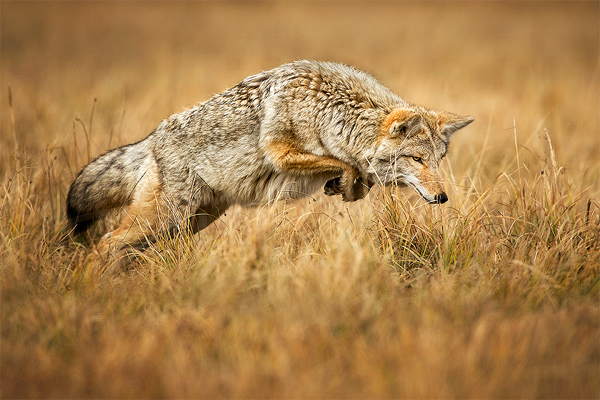
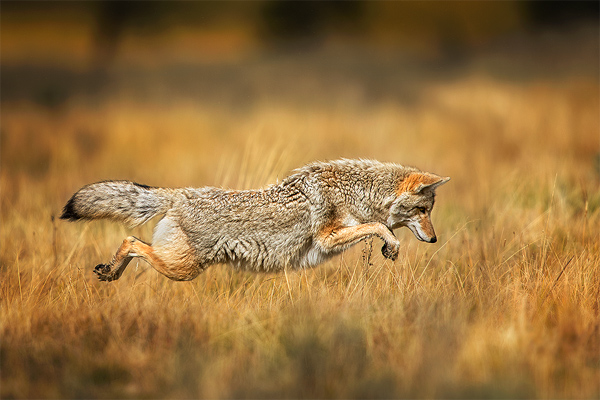
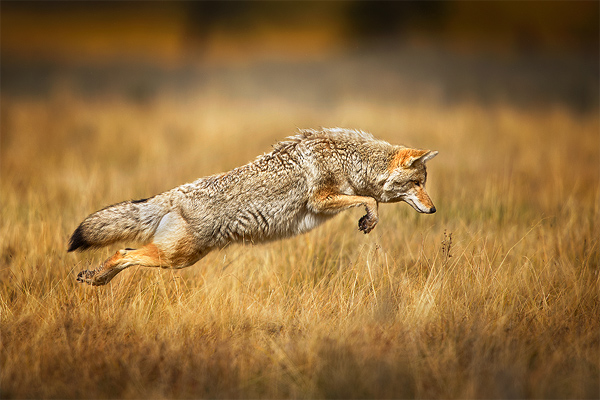
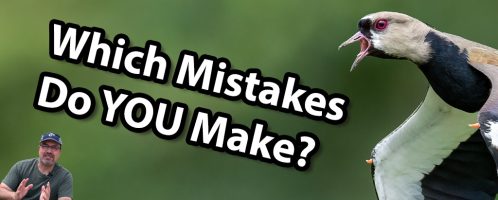
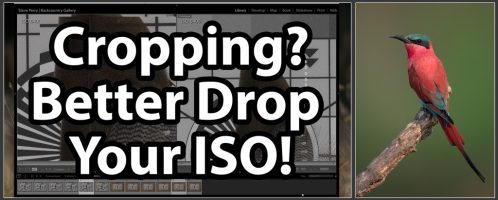
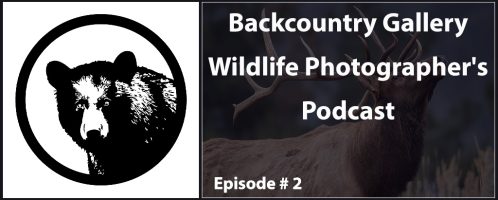
Great photos and both of your e-books are excellent resources. Thanks. The problem I have is when I read about “pouncing coyotes” or watch pro photographers at conferences is the one thing they have access to (that I don’t) is “The World”. Me, I have my backyard and local areas that have the usual animal population but never what I see from the professionals who are in Africa, Yellowstone, India, or where ever. That makes a huge difference in our ability to obtain great photos like the pros get. At the recent Nikon booth Joe McNally gave a presentation on… Read more »
Hi Bob – So many times, we forget what’s in our own backyard. There are opportunities just about everywhere. For example, I live in NW Ohio – not really a Mecca for nature photographers. However, I still manage to get great shots right here at home. For example, we have a local park (a couple really) where the wildlife is fairly habituated to people. Not tame mind you, but you can at least get within range to get a shot. Is it perfect? No, not at all, but it’s still a resource and many of the deer images you see… Read more »
Steve. Don’t get me wrong as I agree with you as to what you can get in one’s backyard. I shot some of my best photos there. However, you soon run out of unique photos of birds and squirrels as the selection is limited and of course I never see the types of photos that you have taken as they are awesome. Travel opens up a whole new world that results in photos that most people never get a chance to see except when pros like yourself take and publish them. Anyway I will keep looking around to see what… Read more »
Sounds like a future article 🙂
Great pics, story & tech specs Steve. I really appreciate the “leaps per frame” info. What time of year & what area were u at when were u there?
It was late September and just near the Lamar Valley.
Hey, Steve, like my friends, I like your book about nikon’s autofocus system. And I do like shooting wildlifes. I use D5 now. But I noticed something very intereting about d153 system. The AF-C d153 system has a time limit when tracking things. It will track things briefly, and how briefly is determined by how you set the AF tracking lock-on. But something very interesting happened, if the background is a pure white wall without any contrast or texture, the time limit regarding AF-C d153 is gone, it can track the initially focused subject forever. This is weird, I really… Read more »
What you are observing is spot on. I have written about the differences in my AF book too. The way it works is that if the primary point slips off the subject, after a short delay (under A3) the camera will attempt to refocus on whatever is currently under the primary AF point. Pretty much what you have observed. However… If the camera doesn’t have anything to lock onto, it will stick with the original target – or at least focus on something under the dynamic AF area. Once you get used to it, it’s not bad – even advantageous… Read more »
Thanks a lot for replying , Steve. I watched a testing video about d5 on TCSTV, it said"between 100 and 800 iso, the histogram looks quite flat and compressed. It looks like the highlights are protected".What does this mean? I did not see any difference on histogram between low iso and high iso in the same scene. The contrast and exposure are exactly almost the same.
No clue – I’d have to see it in context I guess. The histogram is dependent on the scene, so if they were shooting a “flat” scene they’d get a flash histogram. It’s also based on the embedded jpeg, so the histogram can vary depending on the profile they were using.
UDAMAN Steve, BBF is King. Now , you can tell us the “real” way you got the shot , , , laser pointer and Coyote treats ! Auto Focus book is the best ! Good stuff keep it comin !
LOL, you caught me 🙂
Neat, thank you Steve. What cool shots. I have a gimbal on order now, thanks to your recommendations in your books so I’m excited for some wildlife photography on Saturday (elk and bison at the local wildlife refuge).
Yes, the coyote pounce seems similar to what Bobcats (and lynx) do when hunting ground burrowing critters. I’ve had the opportunity/pleasure to see this type of behavior once in Point Reyes National Seashore. The action was pretty far off though. I think I was still using a fairly modest telephoto zoom lens (70-300) at the time, so I don’t have beautiful photos like yours as proof. Good incentive to keep returning I suppose (granted the Government shutdown ends sometime soon). Nicely done and thanks for the detailed tip.
Excellent article Steve. Thank you for dong these!
You are SO on spot about studying animal behavior. Last summer when shooting whales I discovered this very thing. Each animal seemed to have a “rhythm”. Once known, I almost always knew when they were ready to dive and give us a tail flip.
Only wish I had read your book on Nikon focus before going. So many soft shots brought back because of ignorance
Steve, g’day from Australia, find your writing intelligent, insightful, enjoyable and educational, add that touch of humour you possess and the whole read is an absolute hoot. Have just picked up a D810, up from a D610, and plan to put it to some heavy use, especially when we go to Hawaii in November – Big Island, volcano, lava flow and astro then to Oahu. Now I need to re-read the autofocus book, there’s a lot I need to take in with the D810 in hand.
Are your books available as a hard copy or just an e-book? awesome stuff!
They are e-books only. Cheaper for you, easier to give free updates, and no delivery worries for me 🙂
Steve, I have followed your work for some time and have learned a great deal from you. I use manual and auto ISO as you suggest and am mostly pleased with my results. i am currently watching Lynx and would like your advice on what maximum ISO I should set on my D500 for auto ISO. I’m using a 200-500mm at f 5.6 with shutter speeds in the range of 750 to 1200. I would like to use higher speeds but am nervous of too high ISO. I use Lightroom and DxO Photolab for processing, the latter having exceptional noise… Read more »
I cap my D500 out around 4000, but prefer it under 3200. As long as you’re nice and sharp, they should take NR pretty well.
I’d just like to see a coyote. We live in rural central Mi and regularly hear the critters on our property, but darned if we ever see one, let alone get a photo op. Nice series of articles Steve. Keep them going.
I only get good ops in parks – I live in the country and and I hear them all the time – only rarely spot one and forget pics. Much easier in the NPs.
I use a predator call for coyotes, owls, hawks and bobcats. Works pretty well. Hunting with a camera. I am a auto ISO and back button focus guy, largely do to Steve’s influence.
Great work, Steve. Got your Nikon focus book. Loving it.
Do you do workshops?
sorry for duplicate posts. It kept saying captcha code incorrect so didn’t think I was successful the first time.
We have six of them in Costa Rica this year, but we have 30 people on the waiting list. More coming in 2019.
Excellent work, Steve. Bought your Nikon E book. It’s very good. I’m halfway through it.
Do you do workshops?
Wonderful series Steve please keep it going. YNP bear management has changed bear activity over the years so we see fewer bears. Years ago my wife and I tent camped at Lewis Lake, close to the south entrance. One September morning we woke to three black bears roaming through the camp ground. It was not unusual to drive in the middle of the day and have to slow the VW as we followed Grizzly bears meandering in the middle of the road. Times have changed and the impact of increased human pressure may be keeping a lot of the wildlife… Read more »
Great story Steve – as per usual 🙂 Can you tell me where you had the focus point for these shots – on the eye, or did you pre-focus on where you thought it would be mid-air?
Hey Steve. Great read here and I’ve learned so very much from your e-books which I’ve come to rely on since embarking on the wildlife photography journey which has quickly turned into an obsession. The technical insights have been fantastic, but my favorite little gem from this read is the adage “nuttier than a squirrel turd.” Be well.
Just curious, is it possible for those of us that cannot afford $20k worth of gear to get shots like this? For example, a D7200 or D750 with a Nikkor 200-500mm? Or are pictures like these only possible with the higher end gear?
Your pictures are fantastic and, like you, I love coyotes.
Take a look through my wildlife and wildlife action gallery. Some of those are taken with things like a D7200, D7500, and even D7000 (in fact, I had a bunch published last year from the D7200). Some are with a D5 or D4. Some are with the 600 F4, some are with the 200-500, some with the 300 PF. Now, tell me which ones are which 😀 Kidding aside, I don’t see a lot of difference in my final output because of gear. I can get shots like these with just about any mid-range to pro camera / lens. I… Read more »
Thanks, Steve. As it happens, I was photographing a coyote yesterday. The poor girl had a bad case of mange, so the shots won’t be wall hangers. By staying in one spot and looking all around, I was able to convince her that I wasn’t a threat, so she stuck around. Sure wish I had my 150-600 instead of the 100-400, though. 🙂
Hi Steve,
Great shots but as a canon user…well you win!!
What time of year were you at Yellowstone? This is an important question if coming fro Australia and wish to see the wonderful wildlife.
More tips for canon users would be great. Thanks for you regular posts
Brian
This was in late September. It used to be a nice time to be there – not too many crowds. Now, it’s crazy all the time. I went there fall of 2016 and it was really crowded and I actually left early. The crowds seemed to be keeping the animals at bay – unless you wanted bison :/
Dear Steve..thank you very much for sharing your very nice experiences from the Wilderness. I am a very good follower to your esteemed site Back Country Gallery and I learn a Lot from you. I already got the Two Resource Books written by your Wildlife Field Practical knowledge experiences in the Past, and are very very great and important Resources to Me. This your article I read well and wish you all success to do more activities in this year too. Another small question I would like to know is – I am a good and Loving Nikon user..I use… Read more »
Thanks for the kind words and yes, this can be done in any exposure mode. I shot these in Aperture Priority, but now prefer manual + Auto ISO for my autoexposure mode.
My Dear Steve Perry..well understood. Once again thank you very much. With all good wishes..
Good stuff, Steve. Learning pro techniques while seeing great photos and reading entertaining text – what could be better?
Steve, I love the new series! Any insight into how to get closer is especially helpful. It’s usually the cropping that kills my images. And I’ve really learned a lot from your eBooks. Great stuff! Thanks!
I agree with cropping. There are a whole lot of problems that get solved (noise, sharpness, detail, acuity, etc) if you just fill the frame the way you want in the field. (If you can of course!)
My biggest trick is to go where the animals are accustomed to people. More travel, but it works!
I purchased your ‘Secrets to Stunning Wildlife Photography’ I thought about the Nikon book, don’t tell anyone I am a Canon driver, may still get the book though. I have already adopted, definitely not mastered, the back button focus, solving one of my major issues with auto focus lenses. I was also a hard core ISO one value person harking back to my film ASA days, but, I tried the Auto ISO trick setting the limit to 2000, so good so far. I have a great deal to learn on both techniques. First time I saw the pouncing coyote shot… Read more »
Both techniques take practice. Does you Canon allow for exposure comp with M+Auto ISO? I think that’s the downfall for Canon with that technique. I played with a 5D MK IV this summer and it didn’t support exposure comp with M+ Auto ISO. So, if the exposure needed tweaked, no way to do it. I shot in Aperture e Priority or just manual.
Love the story and it is nice to know that you once struggled like the rest of us to perfect your photography.
LOL, you have no idea 🙂 I still struggle with stuff from time to time, it never goes away.
Great captures Steve, I’ve seen at least one of these photos somewhere and was curious how you had gotten it. Thanks…
Coincidentally, I just told my husband we should take a ride this evening to look for coyotes. Thanks for the article. Not only do I appreciate your photos, but I really enjoy your writing style.
Awesome – hope you find some 🙂
Steve: Just a note to say THANK YOU for these excellent free articles. I have bought your email books
and love them. I use for reference all the time and highly recommend these to your readers.
Keep up the great work too. Love the pouncing coyotes. Have shot these before also but nothing compared to yours.
Congrats.
I’ve been an SP follower since last year – when your back-button focus technique probably saved hundreds of quick shots during my photo travels in Morocco, Namibia, South Africa and Merritt Island. I now use manual-auto ISO, a technique I would have never found on my own. So I look forward to these new posts, but I’d like to see a brief description of the non-camera logistics. For instance: For grizzly shooting did you require/use an experienced guide for protection? Do you ever/often get special access to restricted areas – if so, how? Do you ever use an assistant to… Read more »
I’d be interested to know about this too Hap so Steve, when you have a chance, a few more guru words would be great. Cheers. Robert
These posts will keep evolving 🙂 When it’s appropriate I’ll be sure to include any special logistical info. As for the grizzly bears, the first one was out in a meadow. Just myself and another guy keeping a respectable (but shootable) distance for nearly an hour. It was really cool. Bear spray along for the shoot of course. The other two were closer to the road and there were rangers there keeping people in line. You just need to be cautious and keep the distance respectable – that’s why I use the big glass. I don’t have anyone driving bears… Read more »
quote ” I don’t think it’s a good idea to try to force an animal in a particular direction for a photo.”
Especially, bears, and especially bears that love meat (ie. grizzlies)
Let the animal do what it wants, and, in my experience, it will most likely ignore you altogether!
Exactly. I find that if I just sort of hang out with them, after awhile they ignore you. Heck, sometimes they come to you! I’ve had that happen with deer, pronghorn, and even black bear (he got yelled at when he got too close though and sent running).
Any chance we could buy a big print of the pouncing coyote?
I’m not doing too much int eh way of printing nowadays. However, I’ve been getting so many requests lately I may open it up for a week or two when I know I’ll be home. Keep an eye on the newsletter 🙂
after reading your two readers I more understand the possibilities of my camera D610. thnx for it. your new serie is fine to read.
Thank You Steve. What a lovely story around your superb photos. African jackals also pounce sometimes after small mammals in long grass. And so do Servals…a beautiful sight. But it’s very hard to catch them at these antics. Based on my reading, Hugo van Lawick took the first published photos of this behaviour wrt African carnivores – in the Serengeti. This must have been in the late 1960s with MF lenses on film! Check out the excellent books Among Predators and Prey, and especially Innocent Killers, the latter written with Jane Goodall. All time classics still available used
Thanks for letting me know 🙂 I’ll have to look those up.
Love this new series Steve! Great article and inspiration. Thanks!
Enjoyable read. Inspires me to pay more attention to the “yotes” nearby.
OPL….Luv it!!! Hahaha…Still can’t get over it. Luv humor. Anyway, the more I thought about it, you’re spot on as OPL’s can be another thought process in determining your composition. You’re so slick…
Awesome article, Steve! I do love this new series.